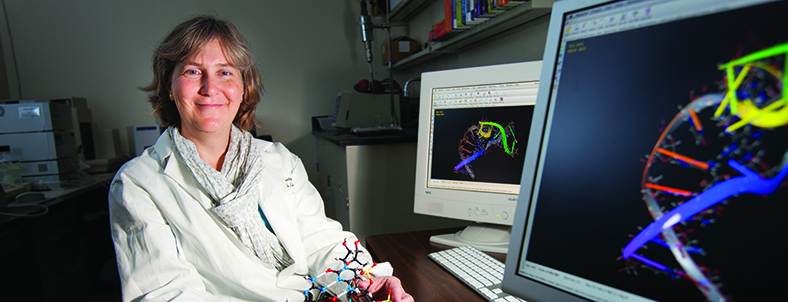The rise of antibiotic resistance among common infectious bacteria is a worrisome health threat that has many scientists looking for a solution. Jennifer Hines, Ph.D., professor of chemistry and biochemistry at Ohio University, is one of the few looking to ribonucleic acid (RNA) structures for new drug discovery. Her research group is studying a key regulator for bacterial gene expression made up of RNA, called a riboswitch, that could be crucial in designing new drugs to kill bacteria.
“Just like a light switch you flick with your finger and turn on or off the light, the global fold of the RNA changes in response to interactions with the signaling molecule,” Hines said. “My research group is working toward designing small molecules that can disrupt that key RNA signaling molecule interaction in order to permanently turn off the switch and kill the bacteria specifically.”
To determine the structure of these potential new antibiotics, Hines’ group tests how different small molecules interact with the RNA riboswitch. Since Hines has to test the docking of entire libraries of small molecules on the riboswitch, she uses the power of the Ohio Supercomputer Center’s Oakley Cluster to speed up the calculation process. This allows her to test multiple RNA sites against many different small molecules to identify the best pairing.
While performing a single calculation with one molecule may take Hines two minutes on her lab computer, the same calculation is done almost as soon as she enters it by using the Oakley Cluster. She also realizes cost savings through using MacroModel and Glide shared software licenses through OSC.
“Bottom line, I cannot afford more than one computer in my lab to be working on it,” Hines said. “If I have multiple students with different projects, they have to line up after one another whereas with the Ohio Supercomputer Center, they can all be working on it at the same time. It allows more people to investigate simultaneously and the calculations just run a lot faster.”
Antibiotics are not the only pharmaceutical area where RNA holds promise. Traditionally, significant advances in drug discovery have occurred through targeting specific proteins or DNA. RNA is present in every living cell also, but in the past was overlooked as a potential therapeutic target. Because it is involved in nearly every biological chemical process, yet has a relatively simple structure, it makes for an enticing target in the world of drug discovery. Hines said it is only within recent years that RNA has become a major player for structural and molecular biologists who are looking for novel therapies.
“It is just mind-blowing what RNA does in bacteria, in humans and in viruses,” Hines said. “We’re just at the dawn of targeting RNA for drug discovery purposes and so with RNA being so elegantly involved in all sorts of regulatory processes, if you get more information about the best ways to target RNA with small molecules, you could potentially open up new areas for anticancer research, antiviral research, in addition to the antibacterial research that I’m doing.”
Project Lead: Jennifer Hines, Ph.D., Ohio University
Research Title: Modeling Ligand Binding To Noncoding Regulatory RNA
Funding Source: Ohio University
Website: https://www.ohio.edu/cas/chemistry/contact/profiles.cfm?profile=hinesj

